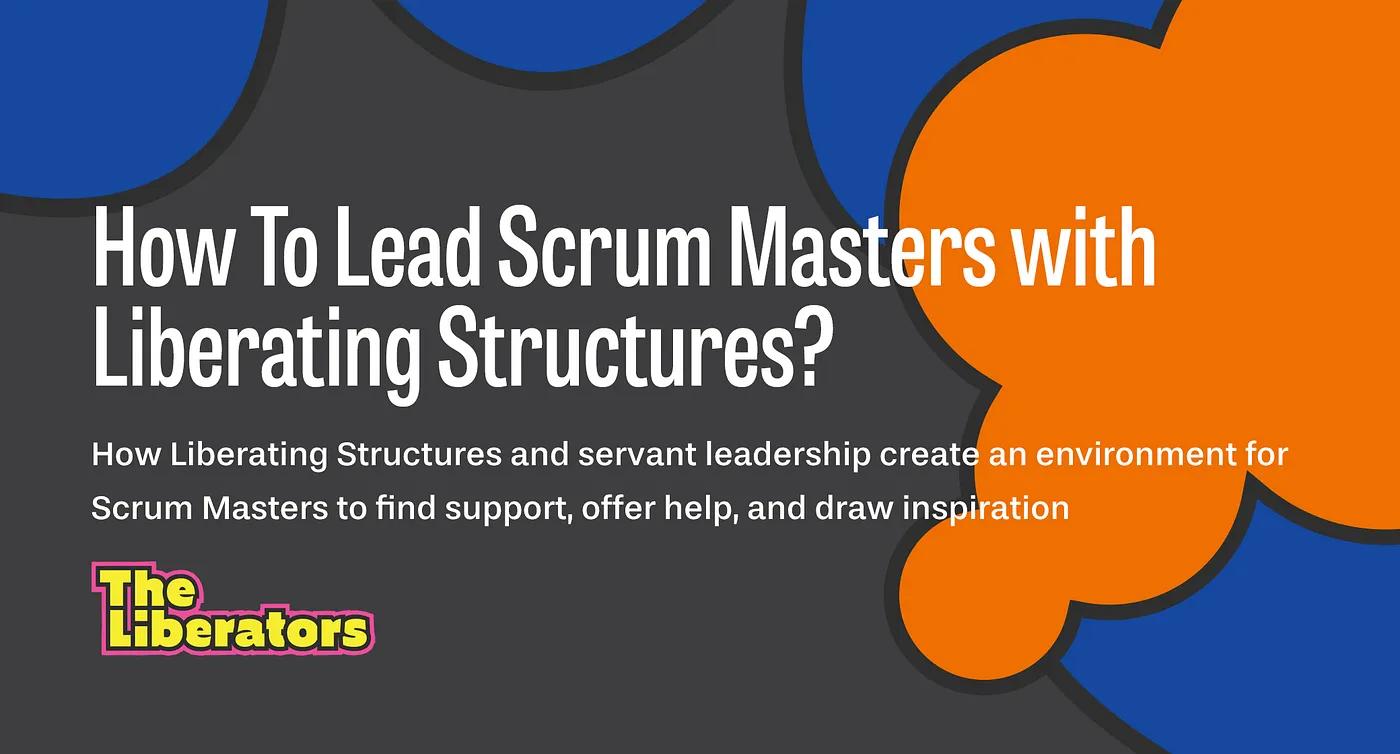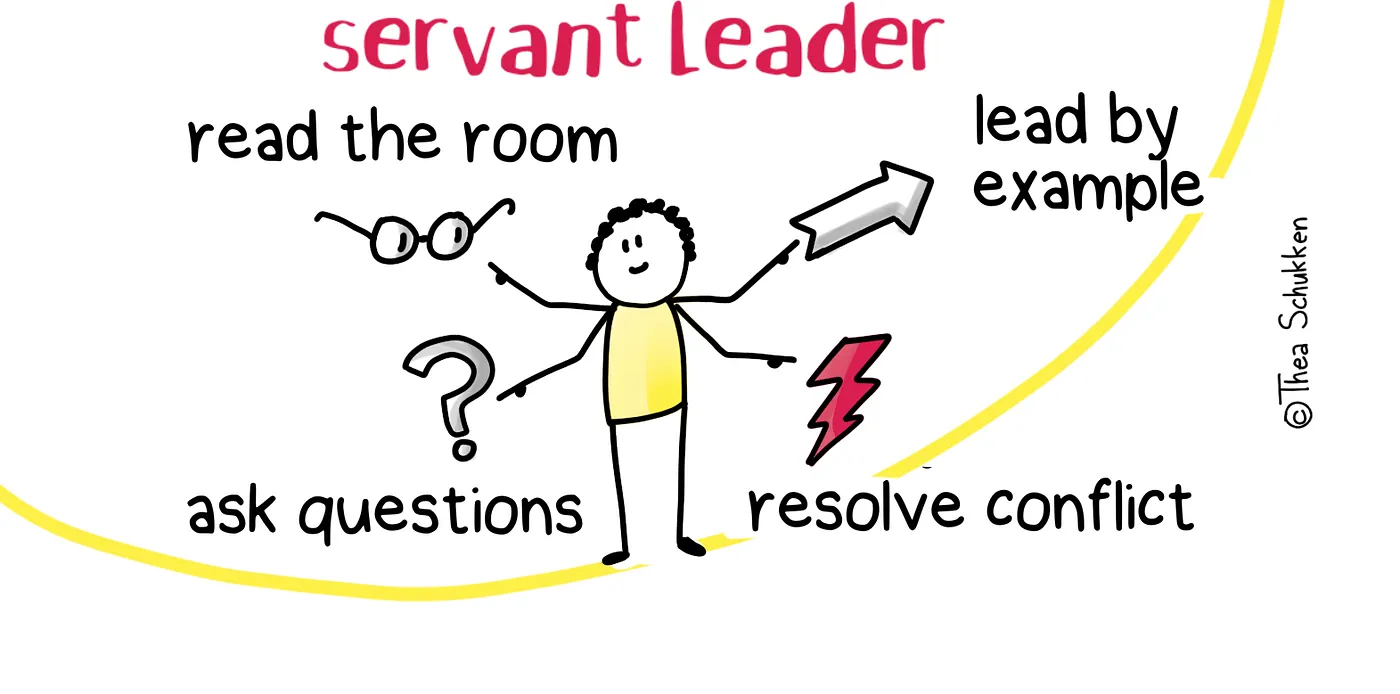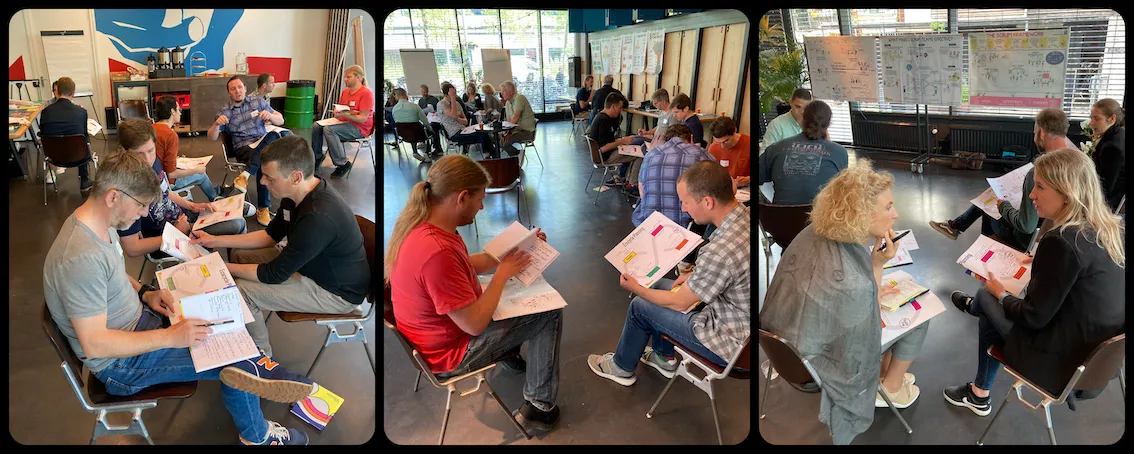
Some time ago, I had an interesting conversation with an Agile Coach from a large car manufacturer in Germany. As an Agile Coach, he’s responsible for about 50 Scrum Masters. Not in a hierarchical way, but more as a servant leader. For about one hour we talked about how to be a servant leader for such a group of Scrum Masters. What are ways to lead, inspire, and guide them?
After our conversation, the topic kept spinning in my mind because somehow it intrigued me. Eventually, it’s actually quite simple. Regardless if you’re an Agile Coach or Scrum Master, servant leadership is the desired mindset, behavior, and attitude. As a servant leader, you teach, facilitate, coach, mentor, remove impediments, and spark change.
In this article, I’ll share my view on servant leadership, explain how it connects to Liberating Structures, and offer examples of how the combination creates an environment for Scrum Masters to find support, offer help, and draw inspiration.
Servant Leadership
Here’s how I describe servant leadership in the paper “The 6 Stances of a Scrum Master”. Rather than drawing attention to yourself, you help others be as effective as possible. You don’t manage or lead the team by telling them what to do or how to do it. The only area where you should take a strong position is when decisions are made that adversely impact the empirical process or the degree to which team members feel safe to take interpersonal risks.
A Scrum Master can show servant leadership by…
- Restraining from solving and instead asking questions encourages the team members to figure out their own solutions;
- Showing vulnerability by being open about problems, personal issues or anxiety lowers the barrier for others to be open as well;
- Creating a safe environment, where constructive disagreement is encouraged and team conflict is considered an opportunity for growth and improvement. But also to intervene in order to protect the Scrum process and the health of the team.
The Scrum Master leads by example, by respect, and by the ability to influence the organization of the Scrum team and its effectiveness. The Scrum Master should lead with values, courage, commitment, and stubbornness. Stubborn by having strong beliefs and the intention to change the organization.
Servant leadership proves to be the backbone of the Scrum Master role. Its philosophy and practices increase teamwork and create an environment in which individual growth can flourish and endure. As a servant-leader, the Scrum Master can help the team act upon the Scrum values of courage, openness, respect, focus, and commitment and realize their full potential.

The philosophy and practices of servant leadership increase teamwork and create an environment in which individual growth can flourish and endure.
Liberating Structures
Liberating Structures are a collection of 30+ interaction patterns that unflatten, enrich, and deepen interactions in groups. With strong roots in complexity science, and collected by Keith McCandless and Henri Lipmanowicz, all Liberating Structures implement five design elements and ten principles. Liberating Structures are simple and easy to learn, making it easy to pick them up and spread them throughout your organization. Their purpose is to involve and unleash everyone, which is essential in environments where everyone’s voice is necessary to navigate complexity.
If you’ve never heard before of Liberating Structures, this description probably feels vague, abstract, and maybe even meaningless. Liberating Structures mostly make sense when you experience them. The longer you talk about the structures, the more confusing it probably gets. So let’s make things more specific.
Liberating Structures & Servant Leadership
Now that I’ve explained the basics of servant leadership and Liberating Structures, how do both connect? How can the combination create an environment for Scrum Masters to find support, offer help, and draw inspiration? How to grow a self-sustaining community of Scrum Masters? Here are some specific examples. It’s not a complete list and structures can definitely be switched. My intention is mostly to show how servant leadership and Liberating Structures are connected.
As a servant leader, you spark change with…
- Purpose-to-Practice (P2P). A great way to start or reboot a community of Scrum Masters is by defining a clear starting point. The first step of P2P is to define the purpose together. What is the purpose of our Scrum Master community? What do we hope it makes possible? From there, P2P covers other essential elements — principles, participants, structure, and practices — that are designed to help achieve that purpose. What rules must we follow in pursuit of our purpose? Who must be included to achieve our purpose? How will we organize ourselves? What are we going to do? Revisit the outcome of your P2P session frequently to include new insights.
- 15% Solutions. Trigger big change by starting small. A 15% Solution is any first step or solution that you can do without approval or resources from others and that is entirely within your discretion to act. Simply put, it is something that you can start right now if you want to. So, it’s a great catalyst for change. Whenever you meet with your Scrum Master community, make it a habit to finish by defining a 15% Solution. Even better, create small groups of Scrum Masters that support each other in making it happen. This also grows the coaching muscles of Scrum Masters.
- Social Network Webbing. Organizations are social systems made up of people who are organized into networks. One of the great things about these networks is you can use them to drive change in, across, and beyond organizations. Social Network Webbing “quickly illuminates for a whole group what resources are hidden within their existing network of relationships and what steps to take for tapping those resources”. Use this structure to support Scrum Masters in making their network visible so they can use it to spark change in the organization.

Encourage Scrum Masters to use Social Network Webbing to make their network visible so they can use it to spark change in the organization.
As a servant leader, you teach and enable teaching with…
- Shift & Share. Organize a session in which some Scrum Masters teach parts of the Scrum Guide to each other. Even topics they might not fully understand yet. For example, what are Sprint Goals? What is meant by the Scrum values? How are transparency, inspection, and adaptation part of the Scrum framework? By teaching it to others, you quickly discover what parts you don’t fully grasp yet. Or, what topics trigger the most questions in the group? Shift & Share is a great structure to enable these teaching moments.
- Simple Ethnography. Get in contact with organizations from whom you’ve heard good stories about working with Scrum. Organize an opportunity to visit this organization and observe its Scrum events. Try to collect as much data as possible. gain insights about how they collaborate, and validate any assumptions you have. What makes Scrum successful in this organization? How are they dealing with the challenges at hand? Afterward, share ideas & insights and discuss what you can improve as a Scrum Master.
- What, So What, Now What. Being a Scrum Master is challenging. You’ll stumble upon tough impediments, face resistance when trying to initiate changes, and sometimes need to navigate conflict. This is where “What, So What, Now What” can be very useful. It helps by asking us to step back and consider what is going on. It structures our thinking by breaking our experience down into three steps: “What do we notice?”, “So, what does this mean?”, and “Now, where do go from here?”. By doing this with others, we are encouraged to discover the gaps in our understanding by learning from their perspectives. Spent time with your Scrum Masters to teach them this structure, and frequently practice it together.

As a servant leader, you coach and enable coaching with…
- Troika Consulting & Wise Crowds. Organize a monthly session focused on giving & getting help. Scrum Masters can bring impediments they faced with their team, and ask other Scrum Masters for advice. It’s also possible they raise personal struggles they experience in their role. Where Troika Consulting offers all participants the opportunity to bring a challenge, Wise Crowds is focused on a specific problem. Small satellite groups work together to give advice on specific impediments. Wise Crowds is not just about the actual problem being solved, but also about developing the behavioral repertoire to do this with a large group. So, as a group of Scrum Masters, you also strengthen your coaching skills.
- Heard, Seen, Respected. As I’ve mentioned earlier, the Scrum Master role is challenging. There’s probably a (wide) gap between the desired state of the team and organization and the current state. In your pursuit of bridging this gap, you’ll probably face situations where you aren’t fully heard, seen, or respected. Instead of keeping these experiences for yourself, the Liberating Structure “Heard, Seen, Respected” offers you an opportunity to share them. Sharing tough experiences in itself can already have a healing effect. Especially because this structure encourages the listener to listen with full attention. No questions are asked. In turn, you simply listen with full empathy and compassion, to the story the other person has to share.
- Helping Heuristics. Helping Heuristics allows Scrum Masters to practice with progressive methods of giving and getting help, and discovering what is made possible by that — both for the Scrum Master asking for help and for the Scrum Masters offering it. In short rounds, Scrum Masters rotate between three roles: coach, observer, and client. During each round, the client first shares a personal challenge, after which the coach applies four progressive methods for giving help. In the meantime, the observer notices patterns in the interaction as well as what is made possible by the four methods. As such, it’s another great exercise to hone the Scrum Master's coaching skills.

As a servant leader, you mentor and enable mentoring with…
- UX Fishbowl. As a mentor, the Scrum Master helps the team to grow through mentorship or to find suitable mentors for them. A mentor actively draws from his/her professional experience and knowledge and helps others learn from that. The UX Fishbowl offers a great setting to share these experiences. Options for ‘fish’ to share their knowledge & experiences are Scrum Masters from other teams or organizations, or anyone else that you feel has valuable things to share.
- Celebrity Interview. This structure offers a different type of opportunity to share knowledge and experience. It allows someone to share their experiences and insights with a group in a profoundly more engaging and interactive way than regular presentations. Instead of having to wait with questions until the end of a presentation — if there’s even time left — Celebrity Interview uses the burning questions on everyone’s mind to structure the conversation. So, invite someone you think the Scrum Masters can learn from, and run a Celebrity Interview.
- Conversation Cafe. A third option to enable mentoring within your Scrum Master community is Conversation Cafe. Ideally, build a rhythm for a monthly Conversation Cafe. It’s an opportunity for Scrum Masters to make sense of the profound challenges they face. Sitting in an (online) circle with a simple set of agreements and a talking object, small groups engage in consecutive rounds of dialogue. Conversation Cafe invites people to listen to one another’s thoughts and reflect together on a shared challenge. When you have multiple small groups, they can all use the same topic and share patterns afterward, or each group picks a topic they consider most relevant.

Conversation Cafe during a Scrum Master workshop with Swisscom and KPN iTV in Switzerland.
As a servant leader, you facilitate and enable facilitation with…
- 1–2–4-ALL. Facilitation is a skill everyone in the Scrum team should master. So instead of considering the Scrum Master as someone who ‘facilitates’, I rather see Scrum Masters as enablers of facilitation in the team. So, when your role is to support Scrum Masters, make them aware of the foundational Liberating Structure like 1–2–4-ALL. You can obviously expand it with other structures, but this would be my starting point. It’s such a simple yet powerful structure to engage everyone simultaneously in generating questions, ideas, and suggestions. And it works everywhere and anytime.
- Impromptu Networking. Another example of a foundational Liberating Structure is Impromptu Networking. This probably doesn’t cover a full session, but can be used to make some first connections, and share stories, challenges, or experiences with each other. Not only is it a good way to ‘break the ice’, but it also doubles as a clever way to use the collective brainpower of the group to rapidly identify patterns. Frequently try this structure together, so each Scrum Master becomes confident enough to try it themselves.
- Design storyboards. This structure exists to purposefully think about how a group wants to spend time together to achieve their purpose most effectively. If you work with Scrum Masters, and you have frequent gatherings, you can use design storyboards to prepare these gatherings together. Optionally, you can ask a small team to prepare for the next session. As such, everyone experiences designing meetings, workshops, and gatherings. Within the, hopefully, safe space of fellow Scrum Masters, you can also give feedback on the session itself on a meta-level. This builds the confidence of Scrum Masters to also design sessions for completely other occasions.
As a servant leader, you enable the removal of impediments with…
- Discovery & Action Dialogue. This structure exists to help groups invent local solutions to the problems they face. Rather than giving up or immediately reaching for “best practices” that worked elsewhere, it helps groups carefully analyze the problem, potential solution, and how everyone can contribute to both. Work together with your community of Scrum Masters to build problem-solving skills in groups by providing them with a useful structure to think about challenges.
- Ecocycle Planning & Panarchy. Both structures help you make unproductive behavior, activities, and relationships visible. While Ecocycle Planning creates transparency on a specific level, Panarchy allows you to analyze the entire system to find opportunities for change. Use it with other Scrum Masters for individual reflection & impediment removal (plot the activities of a Scrum Masters on an Ecocycle), for team reflection & impediment removal (plot the activities of the Scrum teams on an Ecocycle), or for organizational reflection & impediment removal (plot the activities of the organization on an Ecocycle). Whenever it’s beyond the individual level, it’s recommended to involve the people it concerns as well. Instead of talking about other teams, managers, and departments, consider talking with them and making impediment removal a joint effort.

While Ecocycle Planning creates transparency on a specific level, Panarchy allows you to analyze the entire system to find opportunities for change.
- Wicked Questions. This structure creates transparency about seemingly paradoxical realities that exist side-by-side. By accepting both realities, you can engage in deeper strategic thinking and explore new possibilities. As Scrum Masters, you continuously face Wicked Questions. The real question is: are you aware of them? Common questions are “How can we encourage autonomous Scrum teams while also keep moving in the same direction, simultaneously?” or “How can we give Scrum teams time to innovate while also keeping a focus on getting work done?” So, organize a session and work together to make the Wicked Questions transparent. Maybe each Scrum Master faces a unique Wicked Question, but it’s quite likely to discover some patterns. Use these patterns to identify options to productively navigate the Wicked Question.
Closing
In this article, I shared my view on servant leadership, explained how it connects to Liberating Structures, and offered examples of how the combination creates an environment for Scrum Masters to find support, offer help, and draw inspiration. The trigger for this article was a conversation I had with someone who supported a group of 50 Scrum Masters. Obviously, all given examples can also be used at a Scrum team level. In the end, Liberating Structures are powerful enablers of servant leadership, and everyone has the freedom to become a servant leader. Luckily, it’s not connected to a specific role.
I hope this article offered you some inspiration to run some experiments within your organization. If you’ve got other ideas, feel free to share them. Let’s learn and grow, together!
